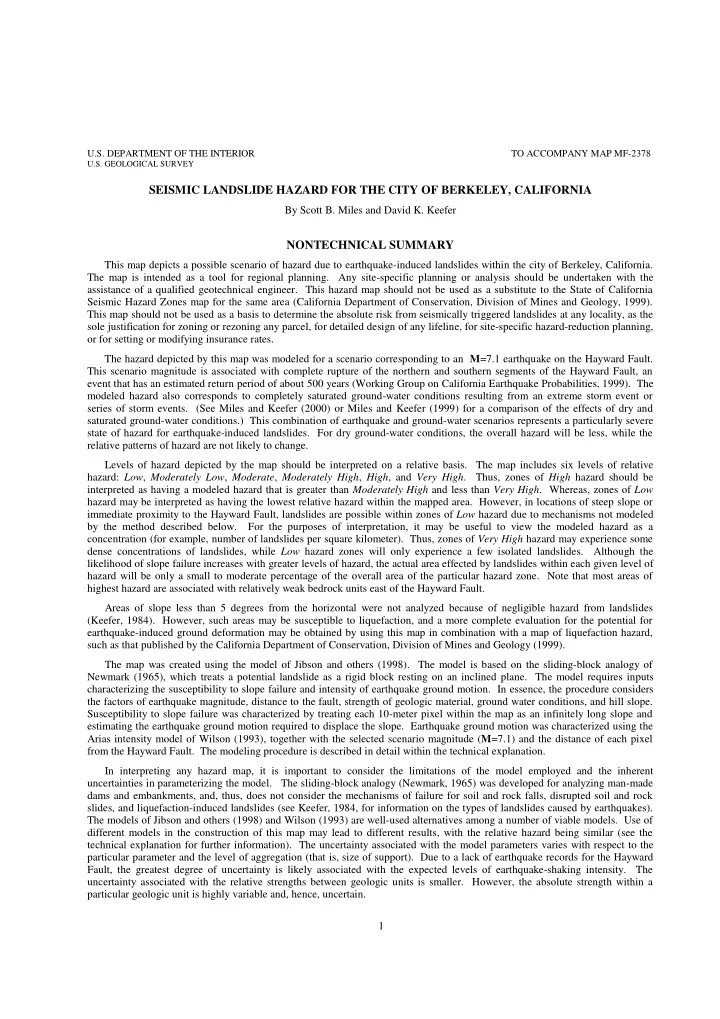

U.S.�DEPARTMENT�OF�THE�INTERIOR �������������TO�ACCOMPANY�MAP�MF-2378 U.S.�GEOLOGICAL�SURVEY SEISMIC�LANDSLIDE�HAZARD�FOR�THE�CITY�OF�BERKELEY,�CALIFORNIA By�Scott�B.�Miles�and�David�K.�Keefer NONTECHNICAL�SUMMARY This map depicts a possible scenario of hazard due to earthquake-induced landslides within the city of Berkeley, California. The map is intended as a tool for regional planning. Any site-specific planning or analysis should be undertaken with the assistance of a qualified geotechnical engineer. This hazard map should not be used as a substitute to the State of California Seismic Hazard Zones map for the same area (California Department of Conservation, Division of Mines and Geology, 1999). This map should not be used as a basis to determine the absolute risk from seismically triggered landslides at any locality, as the sole justification for zoning or rezoning any parcel, for detailed design of any lifeline, for site-specific hazard-reduction planning, or�for�setting�or�modifying�insurance�rates. The hazard depicted by this map was modeled for a scenario corresponding to an M =7.1 earthquake on the Hayward Fault. This scenario magnitude is associated with complete rupture of the northern and southern segments of the Hayward Fault, an event that has an estimated return period of about 500 years (Working Group on California Earthquake Probabilities, 1999). The modeled hazard also corresponds to completely saturated ground-water conditions resulting from an extreme storm event or series of storm events. (See Miles and Keefer (2000) or Miles and Keefer (1999) for a comparison of the effects of dry and saturated ground-water conditions.) This combination of earthquake and ground-water scenarios represents a particularly severe state of hazard for earthquake-induced landslides. For dry ground-water conditions, the overall hazard will be less, while the relative�patterns�of�hazard�are�not�likely�to�change.�� Levels of hazard depicted by the map should be interpreted on a relative basis. The map includes six levels of relative hazard: Low , Moderately Low , Moderate , Moderately High , High , and Very High . Thus, zones of High hazard should be interpreted as having a modeled hazard that is greater than Moderately High and less than Very High . Whereas, zones of Low hazard may be interpreted as having the lowest relative hazard within the mapped area. However, in locations of steep slope or immediate proximity to the Hayward Fault, landslides are possible within zones of Low hazard due to mechanisms not modeled by the method described below. For the purposes of interpretation, it may be useful to view the modeled hazard as a concentration (for example, number of landslides per square kilometer). Thus, zones of Very High hazard may experience some dense concentrations of landslides, while Low hazard zones will only experience a few isolated landslides. Although the likelihood of slope failure increases with greater levels of hazard, the actual area effected by landslides within each given level of hazard will be only a small to moderate percentage of the overall area of the particular hazard zone. Note that most areas of highest�hazard�are�associated�with�relatively�weak�bedrock�units�east�of�the�Hayward�Fault. Areas of slope less than 5 degrees from the horizontal were not analyzed because of negligible hazard from landslides (Keefer, 1984). However, such areas may be susceptible to liquefaction, and a more complete evaluation for the potential for earthquake-induced ground deformation may be obtained by using this map in combination with a map of liquefaction hazard, such�as�that�published�by�the�California�Department�of�Conservation,�Division�of�Mines�and�Geology�(1999).�� The map was created using the model of Jibson and others (1998). The model is based on the sliding-block analogy of Newmark (1965), which treats a potential landslide as a rigid block resting on an inclined plane. The model requires inputs characterizing the susceptibility to slope failure and intensity of earthquake ground motion. In essence, the procedure considers the factors of earthquake magnitude, distance to the fault, strength of geologic material, ground water conditions, and hill slope. Susceptibility to slope failure was characterized by treating each 10-meter pixel within the map as an infinitely long slope and estimating the earthquake ground motion required to displace the slope. Earthquake ground motion was characterized using the Arias intensity model of Wilson (1993), together with the selected scenario magnitude ( M =7.1) and the distance of each pixel from�the�Hayward�Fault.��The�modeling�procedure�is�described�in�detail�within�the�technical�explanation. In interpreting any hazard map, it is important to consider the limitations of the model employed and the inherent uncertainties in parameterizing the model. The sliding-block analogy (Newmark, 1965) was developed for analyzing man-made dams and embankments, and, thus, does not consider the mechanisms of failure for soil and rock falls, disrupted soil and rock slides, and liquefaction-induced landslides (see Keefer, 1984, for information on the types of landslides caused by earthquakes). The models of Jibson and others (1998) and Wilson (1993) are well-used alternatives among a number of viable models. Use of different models in the construction of this map may lead to different results, with the relative hazard being similar (see the technical explanation for further information). The uncertainty associated with the model parameters varies with respect to the particular parameter and the level of aggregation (that is, size of support). Due to a lack of earthquake records for the Hayward Fault, the greatest degree of uncertainty is likely associated with the expected levels of earthquake-shaking intensity. The uncertainty associated with the relative strengths between geologic units is smaller. However, the absolute strength within a particular�geologic�unit�is�highly�variable�and,�hence,�uncertain. 1
Recommend
More recommend